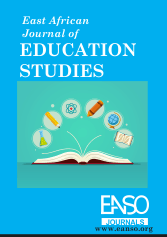Enhancing collaborative online learning in higher education: using Google Docs to analyze Literature texts by teacher trainees
Abstract
The purpose of this project was to explore how collaborative learning can be enhanced through Information Communications Technology in the critical reading and analysis of Literature texts in a particular teacher training course at a selected university in Uganda. The study undertook an interventional research approach whereby critical literacy principles provided the basis for formulating online tasks that would provoke higher order thinking skills such synthesizing, analyzing, reasoning, comprehending, application, and evaluation during the discussion of the play The Lion and the Jewel. A conversational framework was adopted to design a collaborative learning environment by which face-to-face sessions were combined with technology in form of Google Docs. Some of the steps of engagement included identifying the eight participants, sharing of initial content on critical literacy with them, face-to-face sessions and uploading of tasks. The findings reveal that with systematic instructions and guidance Google Docs can provide a collaborative learning platform whereby students can continuously comment about Literature texts in a conversational manner; the intervention proved the possibilities of flexibility in the learning environment; and dialogic teaching especially when discussing Literature texts was greatly enhanced during this intervention. This study was carried out in a real time learning context during the teaching of one of the researcher’s courses. The finding thus can offer some useful guiding steps as benchmarks for actual take up of other ICT tools in teaching and learning in higher institutions of education
Downloads
References
Anderson, L., & Krathwohl, D. A. (2001). Taxonomy for Learning, Teaching and Assessing: A Revision of Bloom's Taxonomy of Educational Objectives. New York: Longman.
Anderson, T. (2004). Towards a theory of online learning. Theory and practice of online learning, 2, 109-119.
Bakkabulindi, F. E. K., & Ndibuuza, F. (2015). Scholars of the dotcom era? The use of ICT by undergraduate students in Uganda Martyrs University, Uganda. Retrieved June 1, 2018, from http://cees.mak.ac.ug/sites/default/files/SAICET-2015-Proceedings.pdf
Bradley, T. (2010). Collaborate in Real Time With Google Docs. PC World, 28 (9), 30-30.
Chatterjee, R., & Correia, A. P. (2020). Online students’ attitudes toward collaborative learning and sense of community. American Journal of Distance Education, 34(1), 53-68.
Churches, A. (2008). ‘Bloom's digital taxonomy’. Retrieved March 9, 2018, from http://edorigami.wikispaces.com/Bloom%27s+Digital+Taxonomy
Cliff Hodges, G. (2016). Researching and teaching reading: developing pedagogy through critical enquiry. Routledge: New York.
Dixon, K. (2011). Literacy, power, and the schooled body: learning in time and space. New York: Routledge.
Fransen, J., P. Kirschner, & G. Erkens. (2011). Mediating team effectiveness in the context of collaborative learning: The importance of team and task awareness. Computers in Human Behavior, 27(3), 1103–1113.
Greenhow, C., & Lewin, C. (2016). Social media and education: reconceptualizing the boundaries of formal and informal learning. Learning, Media and Technology 41 (1), 6–30.
Griffiths, R. (2010). Why I Don't Use Google Docs. Macworld, 27 (5), 48-49.
Janks, H. (2010). Literacy and power. London: Routledge.
Kennedy, D., Mighell, T., & Kennedy, G. (2010). Working Together on Your Own. GPSolo, 27 (4), pp. 14-18.
Kirschner, P. Strybos, J. W., Kreijins, K., & Beers, P. J. (2004). Designing electronic Collaborative Learning environments. Educational Technology Research and Development, 52(3), 47-66
Kirschner, P. A. (2001). Using integrated electronic environments for collaborative teaching/learning. Res Dialogue Learn Instruction 2(5), 1–9.
Laal, M., & Laal, M. (2012). Collaborative learning: what is it?. Procedia-Social and Behavioral Sciences, 31, 491-495. https://doi.org/10.1016/j.sbspro.2011.12.092
Laurillard, D., (2002) Rethinking university teaching: A framework for the effective use of educational technology. Routledge/Falmer: London.
Laurillard, D.M. (2008). The teacher as action researcher: Using technology to capture pedagogic form. Studies in Higher Education, 33(2), 139-154.
McLaren, P. L., & Lankshear, C. (1990). Critical literacy and the postmodern turn. In C. Lankshear & P. L. McLaren (Eds.), Critical literacy: politics, praxis, and the postmodern (pp. 309-419). Albany: State University of New York.
Morgan, W. (1997). Critical Literacy in the classroom: the art of the possible. London: Routledge.
Nakayama, M., & Chen, C. C. (2019). Length of cloud application use on functionality expectation, usability, privacy, and security: A case of Google Docs. Pacific Asia Journal of the Association for Information Systems, 11(3), 2.
Nambi, R. (2018). Using activity theory to explore the possibilities of integrating ICT in the training of Literature in English teachers at Makerere University: A Literature review. International Journal of Learning, Teaching and Educational Research, 17(12), 135 – 148.
National Curriculum Development Centre (NCDC). (2020). Lower secondary school: English language syllabus. Kampala: NCDC.
National Curriculum Development Centre (NCDC). (2013). Uganda Advanced Certificate of Education teaching syllabus for Art and Design, English Literature, Local Language, General Paper (Volume 6). Kampala: Government Printers.
Ndawula, S. (2016) ‘Information and Communication Technology in Secondary Schools of Uganda: Examining the Trends and Hurdles’. Retrieved March 19, 2018, from http://home.hiroshima-u.ac.jp/cice/wp-content/uploads/Seminar/HandOut/135_handout.pdf
Nystrand, M. with Gamoran, A., Kachy, R. & Prendergast, C. (1997). Opening dialogue: understanding the dynamics of language and learning in the English classroom. New York: Teachers College Press.
Soyinka, W. (2005). The lion and the jewel. Nairobi: East African Educational Publishers. (Original work published 1962).
UNESCO. (2014). Teacher issues in Uganda: A shared vision for an effective teachers policy. Dakar: UNESCO. https://unesdoc.unesco.org/ark:/48223/pf0000229777/PDF/229777eng.pdf.multi
Vygotsky, L. S. (1978). Mind in society: the development of higher psychological processes. Boston: Harvard University Press.
Wang, Q.Y., Woo, H.L., & Chai, C.S. (2010). Affordances of ICT tools for learning. In C.S. Chai & Q.Y. Wang (Eds.), ICT for self-directed and collaborative learning (pp. 70-79).
Copyright (c) 2024 Rebecca Nambi

This work is licensed under a Creative Commons Attribution 4.0 International License.




























